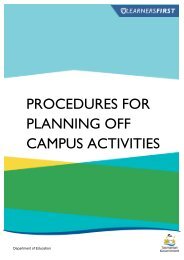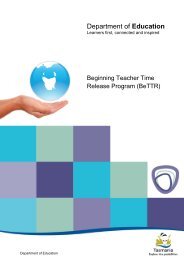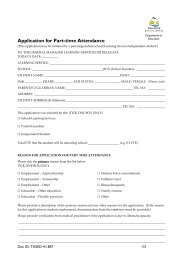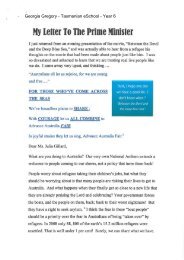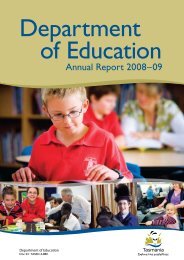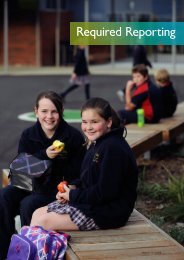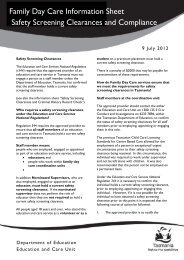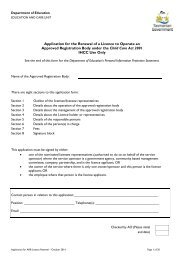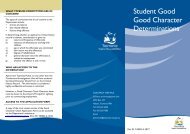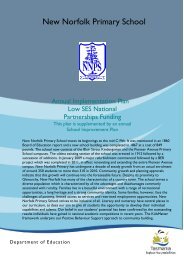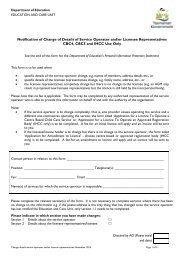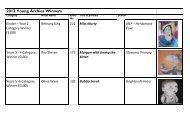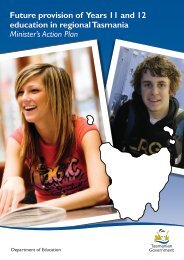Education
DoE Annual Report 2012-2013 - Department of Education
DoE Annual Report 2012-2013 - Department of Education
- No tags were found...
Create successful ePaper yourself
Turn your PDF publications into a flip-book with our unique Google optimized e-Paper software.
Services<br />
There were 203 government schools 1 at the<br />
commencement of 2013 – including senior secondary<br />
schools and the Tasmanian Polytechnic, comprising: 2<br />
• 131 primary<br />
• 30 secondary<br />
• 25 combined (Kindergarten–Year 10)<br />
• 8 senior secondary 3<br />
• 1 polytechnic (in various locations across the state)<br />
• 8 special. 4<br />
Schools (not including the Tasmanian Polytechnic) are<br />
distributed across the following Learning Services:<br />
• Learning Services (North) – 56<br />
• Learning Services (North-West) – 55<br />
• Learning Services (South) – 91.<br />
<strong>Education</strong> services for students who are unable to attend<br />
a school are provided by the Tasmanian eSchool.<br />
The LINC Tasmania network provides services through<br />
89 physical service points in 69 locations across the state,<br />
together with LINC Online.<br />
1. This is a count of school entities and is not a count of school campuses.<br />
2. Includes school changes as at the commencement of 2013 – see<br />
‘New arrangements’ section in this chapter for further information.<br />
3. Senior secondary schools were previously referred to as colleges.<br />
4. Count of special schools includes four Early Childhood Intervention<br />
Service Centres. Although these are services, they are classified in<br />
the department’s organisational structure as ‘schools’.<br />
Early Years and Schools<br />
The Early Years and Schools Division delivers its services<br />
to approximately 63,000 school aged students 1,2 attending<br />
203 schools. It oversees schooling delivered through<br />
programs operating in schools, senior secondary schools<br />
and in established child and family centres. <strong>Education</strong>al<br />
leadership within Early Years and Schools is provided by a<br />
Deputy Secretary with support from a General Manager<br />
for Curriculum and Program Services and General<br />
Managers in three Learning Services.<br />
Eleven networks of schools across the three<br />
Learning Services are each supported by a principal<br />
network leader whose role is to support the school<br />
principal with a focus on school improvement and<br />
accountability.<br />
The Early Years and Schools Division is continuing to<br />
progress the priorities outlined in the department’s<br />
Learners First Strategy and key areas outlined in<br />
the School Support and Expectations 2013 resource.<br />
2013 has seen an ongoing emphasis on the implementation<br />
of the Australian Curriculum. During 2012, English,<br />
Mathematics and Science was successfully implemented<br />
in all schools. History was voluntarily taken up by almost<br />
half of the schools. In 2013, all government schools are<br />
implementing the Foundation to Year 10 (F–10) History<br />
curriculum and some schools have voluntarily opted to<br />
implement the F–10 Geography curriculum.<br />
Improving literacy and numeracy will always be a priority<br />
for the department. In alignment with the Literacy and<br />
Numeracy Framework 2012–2015 the department has<br />
developed birth to Year 12 literacy and numeracy support<br />
packages for teachers. Lead teachers in literacy and<br />
numeracy in each network provide direct support to<br />
schools and teachers. Eight curriculum teacher leaders<br />
with specific learning area responsibility across<br />
Years 9–12 have been appointed to provide direct<br />
school based support for the Australian Curriculum with<br />
a focus on literacy and numeracy.<br />
Student safety, health and wellbeing are important<br />
priorities. The Early Years and Schools Division is<br />
developing the Building Better Behaviour resource for all<br />
staff, to enable whole school approaches that support<br />
positive classroom management and teacher and learner<br />
wellbeing. This will be launched in October 2013.<br />
The division is responsible, through its regulatory<br />
authority, for implementing the National Quality Framework<br />
for Early Childhood <strong>Education</strong> and Care. This includes a<br />
national system of regulation, and assessment and rating<br />
of education and care services which aim to improve the<br />
quality of outcomes for children attending these services.<br />
The regulatory authority also licenses and monitors a<br />
number of other child care services, mostly occasional<br />
care, under Tasmanian legislation.<br />
1. Includes students in all senior secondary schools (previously referred to<br />
as colleges). Senior secondary students were not included in the figures<br />
published in the 2011–12 Annual Report given that the colleges were not<br />
part of the Early Years and Schools Division during that period.<br />
2. Does not include the students in the Tasmanian Polytechnic.<br />
Aboriginal <strong>Education</strong> Services (AES) supports<br />
schools, child and family centres and Learning Services in<br />
their programs and services for Aboriginal students and<br />
their families. The work of the service is closely aligned<br />
to the six priority areas of the Closing the Gap Strategy<br />
which is at the centre of the Australian Government’s<br />
National Indigenous Reform Agenda and the Tasmania’s<br />
Aboriginal <strong>Education</strong> Framework 2012–2015. AES provides<br />
comprehensive support to schools to address the<br />
challenges of readiness for school, engagement and<br />
connections, attendance, literacy and numeracy, leadership,<br />
quality teaching, workforce development and pathways<br />
to post-school options. AES plays a key role in the<br />
development of the department’s policies and initiatives.<br />
Curriculum Services has a team of curriculum<br />
officers who work with the Professional Learning Institute,<br />
Learning Services, <strong>Education</strong>al Performance Services,<br />
Information Technology Services and the Tasmanian<br />
Qualifications Authority to provide teachers and school<br />
leaders with support to implement the Australian<br />
Curriculum and deliver the Tasmanian Curriculum. The team<br />
provides targeted curriculum and pedagogical support<br />
for school leaders through curriculum teacher leaders,<br />
principal network leaders, literacy and numeracy lead<br />
teachers, local networks and lead schools. It supports<br />
dynamic learning environments through access to high<br />
quality digital resources and networks. Curriculum Services<br />
supports improved literacy and numeracy outcomes<br />
through a lead school network model of statewide<br />
support for literacy and numeracy. Curriculum Services<br />
also provides high level educational leadership in each of<br />
the curriculum learning areas and supports developing<br />
program continuity to assist transition and retention from<br />
Years 9–12. In addition, it works in collaboration with<br />
relevant inter-agency and community service providers to<br />
promote health and wellbeing learning outcomes.<br />
Early Years is responsible for the promotion of early<br />
years learning for young children. The Early Years team<br />
provides support for schools and their communities in<br />
12 Department at a Glance » Services




